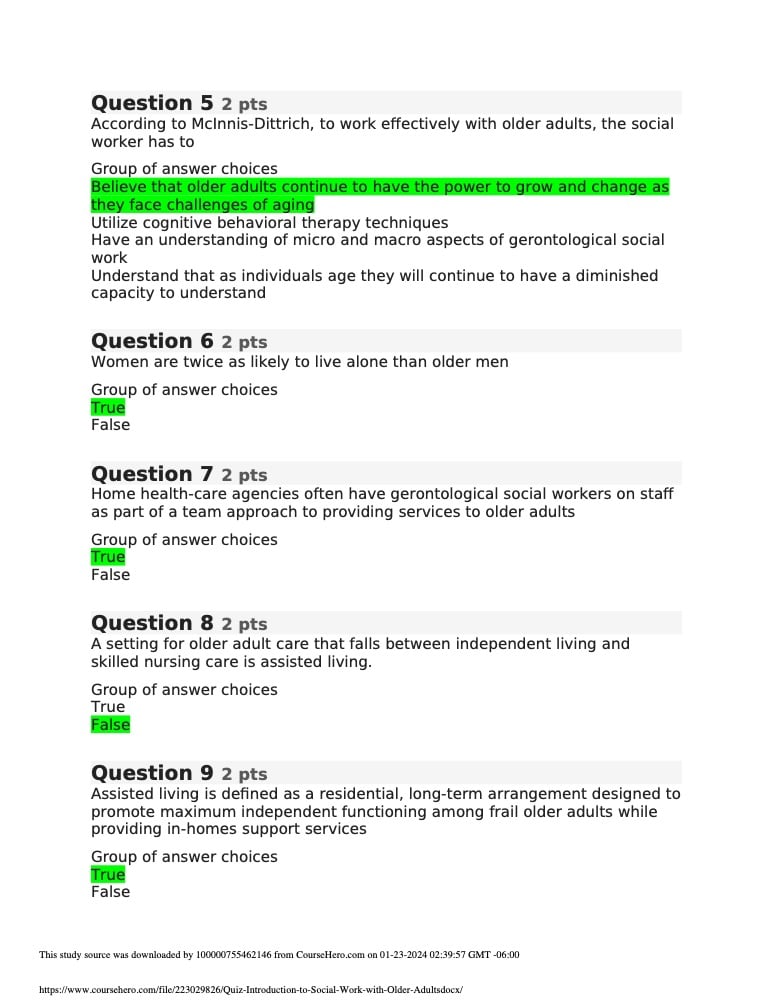SOWK 350 Quiz 2
SOWK 350 Quiz 2 Liberty University
- In the video on “What To Do,” Oasis was able to identify and reflect the feeling of frustration that Michaela was dealing with.
- In the video on “What To Do,”
- In the video on “What Not To Do” with questioning and exploration skills,
- The difference between the oppressor within versus the oppressor without is:
- In life span theory on resilience, important factors include all EXCEPT:
- Resiliency theory applies to which of the following populations:
- Oppressed people may
- The following are considered sources of resilience in Werner’s research:
- Within a specific population of people, whether it is a cultural group or particular group of persons of color, social workers need to remind themselves that members of that group may have individual differences as well as similarities.
- An example of Bulhan’s indicators of oppression assessment could be seen with which of the following individual(s)?
- A child who is attached to a caregiver is an example of ________________ in resiliency theory.
- Which of the following would fit into Rak and Patterson’s “buffering hypothesis” in resiliency theory?
- Cognitive hardiness as defined by Kobasa and Pucetti (1983) involves:
- We should be careful in our examination of oppression because
- People who believe they have some control over their life and know their values and goals in life, demonstrate:
- Most all children exposed to trauma and dysfunctional environments had evidence of negative developmental outcomes.
- An elderly person, according to research that has been conducted, is more likely to manage aging well if:
- In research done on resiliency in children, which of the following was NOT found to be a key factor for resiliency?
- The belief that as a survivor of sexual abuse, one’s identity is that they are “damaged goods,” is an example of:
- Maximum performance potential has to do with one’s developmental reserve capacity, when looking at resilience in aging research.
Set 2
- Resiliency theory applies to which of the following populations:
- In research done on resiliency in children, which of the following was NOT found to be a key factor for resiliency?
- The following are considered sources of resilience in Werner’s research:
- In the video on “What To Do,”
- The difference between the oppressor within versus the oppressor without is:
- A child who is attached to a caregiver is an example of ________________ in resiliency theory.
- We should be careful in our examination of oppression because
- Most all children exposed to trauma and dysfunctional environments had evidence of negative developmental outcomes.
- The belief that as a survivor of sexual abuse, one’s identity is that they are “damaged goods,” is an example of:
- Maximum performance potential has to do with one’s developmental reserve capacity, when looking at resilience in aging research.
- Oppressed people may
- An elderly person, according to research that has been conducted, is more likely to manage aging well if:
- Within a specific population of people, whether it is a cultural group or particular group of persons of color, social workers need to remind themselves that members of that group may have individual differences as well as similarities.
- In life span theory on resilience, important factors include all EXCEPT:
- Cognitive hardiness as defined by Kobasa and Pucetti (1983) involves:
- People who believe they have some control over their life and know their values and goals in life, demonstrate:
- An example of Bulhan’s indicators of oppression assessment could be seen with which of the following individual(s)?
- In the video on “What Not To Do” with questioning and exploration skills,
- Which of the following would fit into Rak and Patterson’s “buffering hypothesis” in resiliency theory?
- In the video on “What To Do,” Oasis was able to identify and reflect the feeling of frustration that Michaela was dealing with.
